Eastern Snake River Plain Aquifer
In This Document
Summary
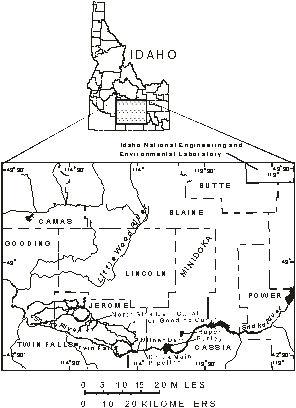
Location map of study area.
Eastern Snake River Plain aquifer Nitrogen fertilizer use in south-central Idaho equals some of the higher fertilizer application rates in the U.S., yet nitrate concentrations in groundwater from the Eastern Snake River Plain aquifer (ESRP) rarely exceed the U.S. Environmental Protection Agency maximum contaminant level of 10 mg/L (as N). We used stable isotope data to determine fractions of irrigation water in ground-water mixtures, and chlorofluorocarbon (CFC) and tritium/helium-3 (3H/3He) data to determine the age of the irrigation water fraction. The results indicate that dilution with low-NO3- irrigation water from the Snake River, and relatively low residence times of groundwater in the ESRP aquifer lower the potential for NO3- contamination above 10 mg/L. Two groups of waters were recognized: (1) regional background water, unaffected by irrigation and fertilizer application, and (2) mixtures of water from the Snake River with regional background water. NO3- concentrations in groundwater increase with fraction of irrigation water in the mixture indicating that elevated NO3- concentrations result from leaching of excess nitrogen by irrigation recharge water. The fractions of irrigation water in the mixtures contain about 1 to 8 mg/L dissolved NO3-. The 3H/3He ages of irrigation water in most mixtures ranged from about 0 to 8 years. The study presents new data comparing CFC and 3H/3He dating of water recharged through deep fractured basalt, and methods of dating young fractions in groundwater mixtures. The CFC ages of irrigation water in mixtures ranged from values near those based on 3H/3He dating to values biased older than the 3H/3He ages by as much as 8 to 10 years. The old bias in CFC age relative to 3H/3He age was attributed to gas exchange of infiltrating irrigation water with old air in the thick unsaturated zones above the Snake River Plain aquifer. Unsaturated zone air sampled from the annulus of blowing wells had CFC-12 and CFC-113 concentrations that were 60 to 95 percent, and 50 to 90 percent, respectively, of modern air concentrations, and were consistently contaminated with respect to CFC-11. Irrigation water diverted from the Snake River was contaminated with respect to CFC-11, but near solubility equilibrium with CFC-12 and CFC-113. 3H/3He and CFC dating of fractions of irrigation water in ground-water mixtures from the ESRP aquifer shows that source of irrigation water and hydraulic properties of the aquifer play an important role in determining the impact of agricultural land-use practices on ground-water quality.
Diagrams
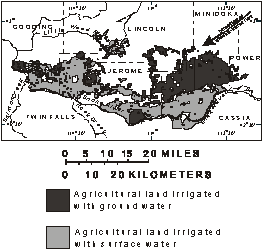
Location of agricultural land north of the Snake River that is irrigated with ground water and surface water.
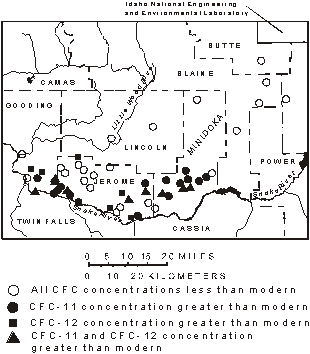
Location of areas where CFC-11 and CFC-12 concentrations in ground water are less than that for solubility equilibrium with modern air, and areas where waters contain CFCs in excess of solubility equilibrium concentrations.
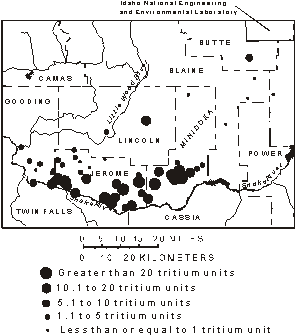
Map showing tritium concentrations in ground water, eastern Snake River Plain aquifer.
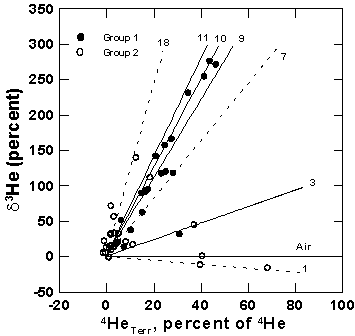
Plot showing δ3He (percent) as a function of terrigenic helium (as percent of 4He concentration). The lines, which diverge from the solubility of helium in water in solubility equilibrium with air at 11 oC and 1200 m elevation, correspond to addition of excess helium with 3He/4He ratios of 1 to 18x10-6. Group 1 waters contain little or no irrigation water. Group 2 waters are ground water mixtures containing a fraction of surface-water from irrigation. The line for Air corresponds to addition of helium with a 3He/4He ratio of 1.384x10-6
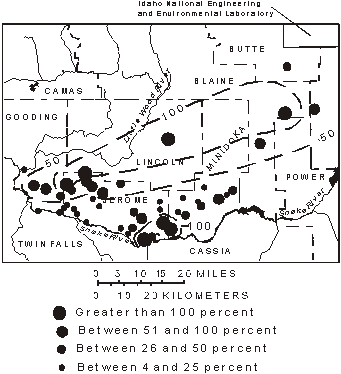
Map showing excess 4He in ground water from the eastern Snake River Plain aquifer, as percent of that in excess of solubility equilibrium concentrations.
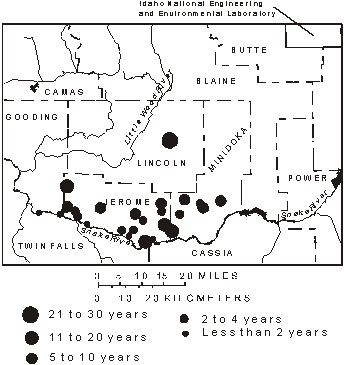
Map showing 3H/3He age, in years, of the young fraction of ground water in the eastern Snake River Plain aquifer.
Photos

Billboard above Shoshone Falls explains diversion of the Snake River for irrigation

Crop irrigation from ground-water sources
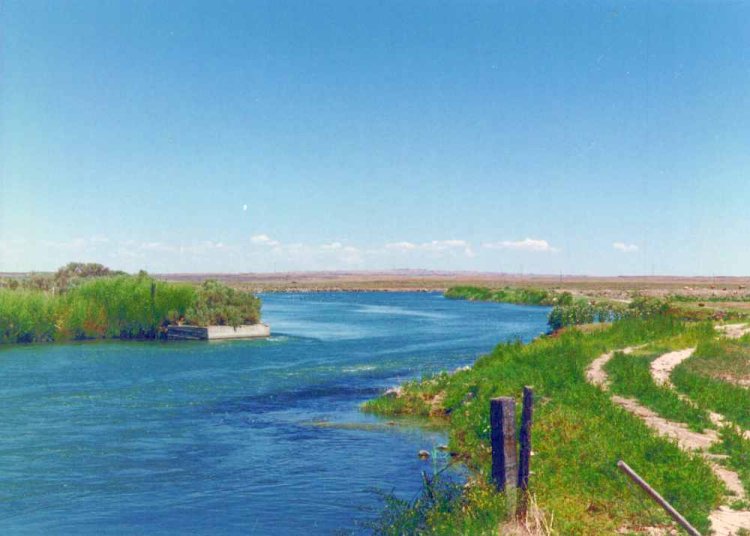
Diversion of Snake River near Milner Dam
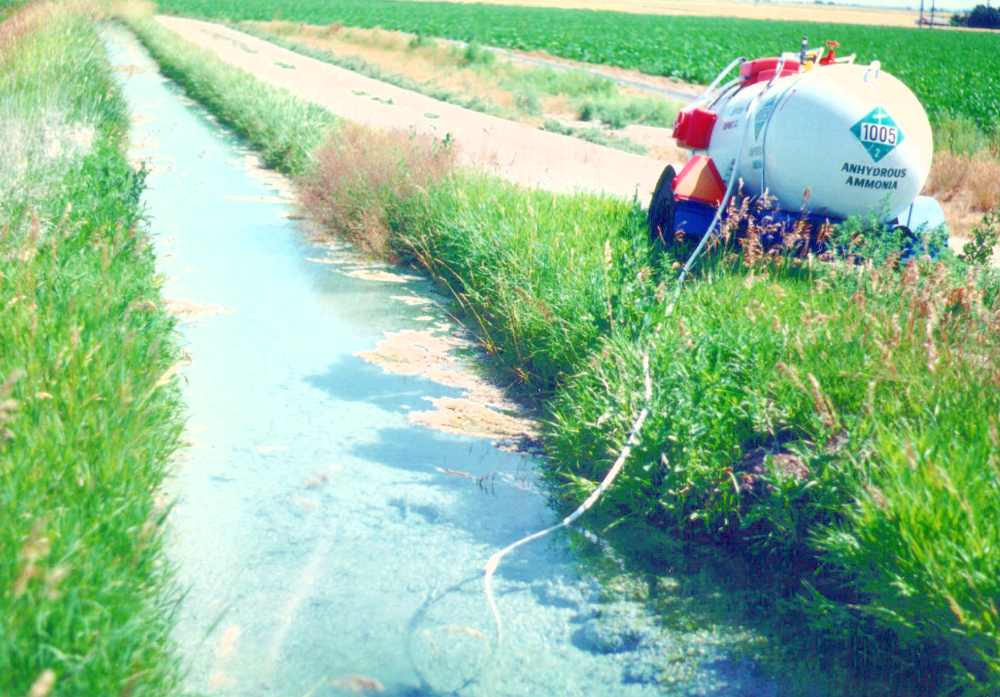
Injection of anhydrous ammonia into irrigation water
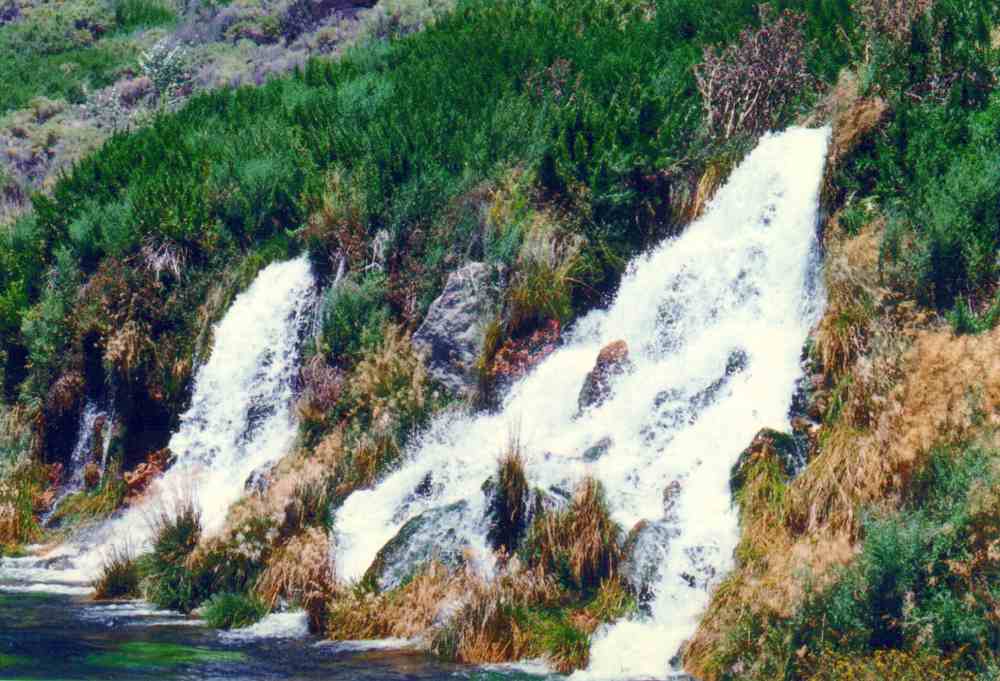
Discharge of the Eastern Snake River Plain aquifer from basalt cliffs above the Snake River gorge
Investigators:
L.N. Plummer (U.S. Geological Survey, 432 National Center, Reston, VA 20192), M.G. Rupert (U.S. Geological Survey, 201 W. 8th Street, Pueblo, CO), E. Busenberg (U.S. Geological Survey, 432 National Center, Reston, VA 20192), and P. Schlosser (Lamont-Doherty Earth Observatory of Columbia Univ., Palisades, NY 10964).
Publications
Plummer, L.N., Rupert, M.G., Busenberg, E., and Schlosser, P., 2000, Age of irrigation water in ground water from the Eastern Snake River Plain aquifer, south-central Idaho. Ground Water, 38(2), 264-283.